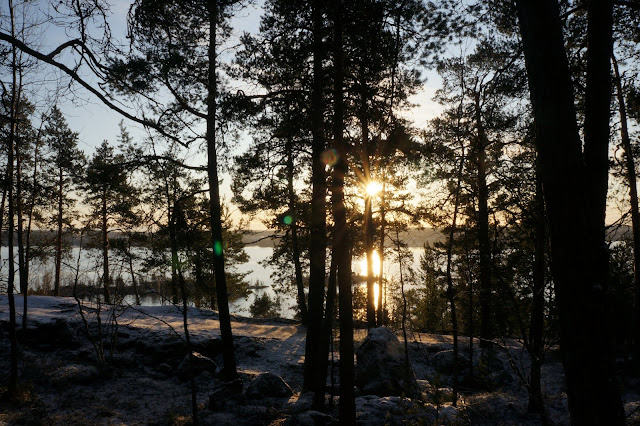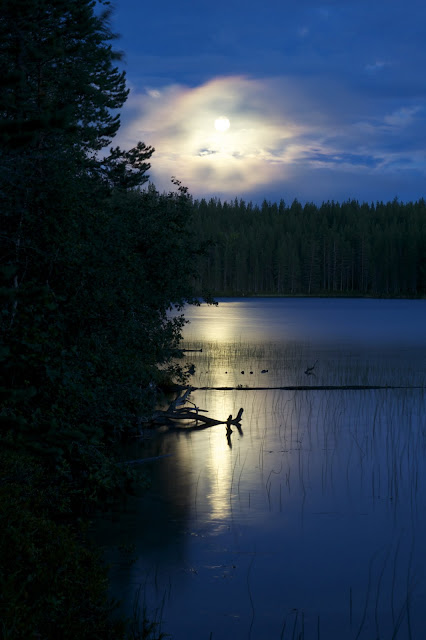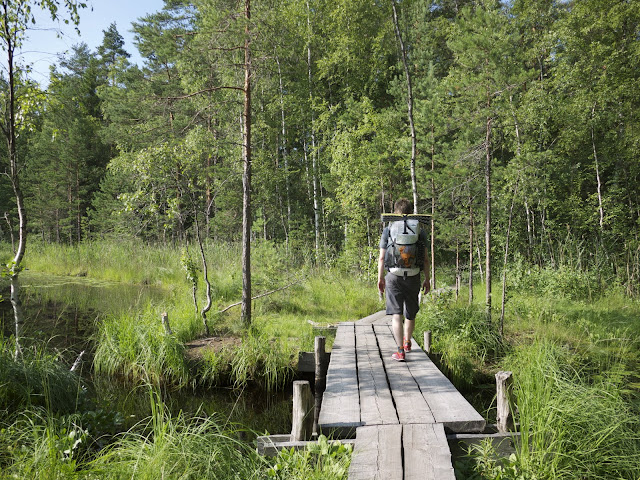Over the holidays I read a post by Jake “Don´t Panic” Dow on
Going stoveless. He and his girlfriend hiked the PCT without a stove of any sort, quite a task in itself, and doing the whole thing without carrying a stove and food for cooking makes it even more interesting. But is going stoveless really lighter, more convenient and as easy as just leaving your stove at home?

Before we set off on cooking vs. no cooking, I'd like to know from you, my valued readers, how many hot meals and/ or beverages you have per day when you hike:
I myself am in the two to three camp. I have a hot breakfast (my MYOMüsli) and even more important than that, a hot cup of coffee. Yes, I'm addicted to caffeine (I can do and have done without, though I enjoy a good tasting cup of coffee in the morning to start my day), and prefer to enjoy my fine java beans hot. Iced coffee is another story (and only really possible in winter with proper snow unless you carry ice with you, which ain't UL I imagine) but cold coffee is somehow "not my cup of tea". The same goes for cacao - I prefer my chocolate hot! Anyway. That's one warm meal to start my day.
Which brings us to meal number two. Even in the summer I often eat a hot cup of ramen noodles/ MYOG tomato-lentil-soup/ pasta/ whatever. Maybe it is the deep-engrained habit of having a hot meal for lunch. [
Off topic: I remember as I was maybe seven or eight that Mom, Dad, my brother and me had a discussion about hot vs. cold lunch. My mom is Dutch and my dad was German, and both had different habits: Mom has grown up with a cold lunch - bread, salad, cheese, spreads, etc. - while dad was used to a hot lunch. In a family meeting the question was if we continue to eat a cold lunch, or a hot lunch. We decided to eat a hot lunch, and somehow that has stayed with me since. Further Offtopic: Finnish Students enjoy one of the best lunch systems in the world: A State subsidized lunch which includes salad, a hot meal (choice of two to three different ones) and two beverages for 2,40€. After six years of studying a hot lunch has become very common, and has continued to be the norm in my working life.] Maybe it is just that I feel a warm lunch gives me more "power" to continue/ fuel my body after an good morning hike. Maybe it is that I feel a warm meal is lighter and easier to prepare than a cold meal. I also feel a second cup of coffee or tea helps with digestion and relaxation - I'm usually not in a hurry. However, I'm also just as often as having a hot lunch not having any lunch at all, and just munch more GORP, snacks, chocolate and müsli bars or even a sandwich should I have one. So this is a 50/50 situation, where I'd guesstimate both warm and cold are equally often the case.
Dinnertime. If I'm not consuming one of my
MYOG Meals, you most usually will see me eat one out of a variety of
Freeze-Dried Meals. I have sat next to people who have cooked meals in the evening, and have felt envious with the tasty smells wafting through the air, up my nose, while me eating my Freeze-Dried Meal (Sorry, there's no Freeze-Dried Meal that can beat a cooked meal in my experience - yes, even Fuizion and Real Turmat). Imagine you're sitting there, eating your with cold water hydrated Freeze-Dried Meal while a mate with a stove is eating something he cooked? I can picture a rampage and slaughter at camp. Surely a reason to camp stealthy, far from anyone who possibly would cook something!
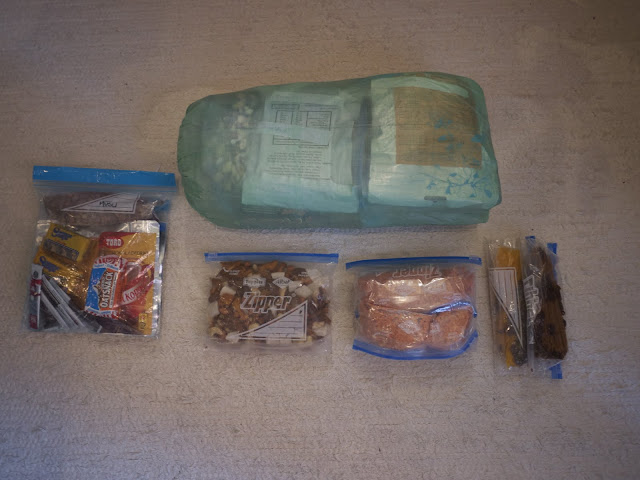
It's all mental, though - just as much as leaving behind the pair of spare clothes, the tent and the luxury hygiene set when you decided to go UL and now walk for a week in the same clothes, sleep under a tarp and your hygiene set is a mini dropper bottle of Dr. Bronners, a toothbrush and a 60 cm x 40 cm towel. So going stoveless would just be the logical next step in the pursuit of a lighter backpack and a more enjoyable outdoor experience.
Which brings us to weight savings: The weight of your stove vs. food which doesn't need to be cooked. My hypothesis is that even with a UL stove which is used to boil water for rehydrating food and a cup of coffee/ tea/ hot chocolate it should be lighter to go with a stove than go stoveless. I'm entering the realm of
Turnerism here, and will rely on statistics, so it is nothing for the faint-hearted. I'll start with a real-life food list: ten days, the full set of breakfast, lunch, snacks and dinners, all which need to be re-hydrated; as used on my packrafting/ canoeing/ kayaking expedition in May.
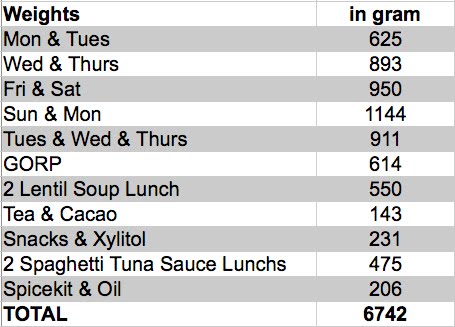
6742 gram for the food on the trip. I carried a Backcountry Boiler incl. stuff sack with me, which is 282 gram [There obviously are lighter alternatives than the Backcountry Boiler, but they would require a pot and often a source of fuel other than wood which would add carried weight]. I will assume all "cooking" has been done in Freezer bags, so there's no need for a pot. Both with stove and without stove I surmise that a cup would be used to consume the beverages, so I leave this out.
If we assume that the stoveless hiker eats exactly the same food as the hiker with stove, he would in this case have saved 282 gram for the stove. That's substantial already in the UL universe. What we can't weight, however, is the satisfaction/ happiness/ tastiness of hot food vs. cold food (This assumes that hot food is tastier than cold food, a fact which is difficult to prove).
From the article mentioned in the beginning, I take that at least the lunch consisted of a Bagel sandwich with cheese and hummus, which definitely sounds tasty. However, it also sounds heavier than a bag of ramen (which also can be eaten cold, though seems to have a texture which ain't easily consumed). If we assume only a 5% increase in weight over the stove-lunch for the bagel, cheese and humus, the stoveless hiker is already carrying heavier food than his mate with a stove - only 55 gram heavier, but nevertheless. One can extrapolate this further to 15 days (stoveless 224 grams heavier) to 20 days (stoveless 392 grams heavier) and so on, though I think you get my point. The stoveless hiker would need to rely a lot on dehydrated food to keep the equation in his favour, add something more tasty and fresh and you add weight which quickly will make hiking with a stove being lighter. If he really has the weight scale with him, the stoveless hiker always could carry 282 grams (the weight of the chosen stove in this example) of extra tasty food with him and remain at the same level than the hiker with a stove.
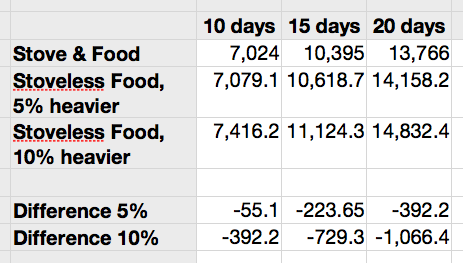
But would it be possible for the stoveless hiker to save even more weight than the weight of the stove, while eating at least as tasty food (again, to define tasty we enter the realm of personal preferences. I, for example, still dislike Brussels sprouts and make a face when my wife brings them home and makes me eat them =)?
Raw foodism is gaining popularity, and would be the perfect stoveless hiking diet - if not raw fruits, vegetables, nuts and seeds would be the foundation of this diet. While the latter two are popular among UL backpackers for their low weight and high calorie count, the former two are rarely found on a UL backpackers food list. Sure, dehydrated fruits are light and tasty, but dehydrated veggies? Jack writes that mashed potatoes are easy and tasty when spiced up with Fritos and/ or spices. I believe that, and hence think it should be possible, with the help of dehydrated meats and fish (beef jerky, salmon jerky) to make a rather tasty stoveless diet which is much lighter than the stove diet - maybe not for a thru-hike, but at least for a long weekend or a week (I like variation). I believe the biggest thing here is again mental: The decision to leave the stove at home, to resign from the hot coffee and tea, and to be content with your cold, lighter stoveless diet isn't probably easy if you're at home planning a trip.
Furthermore, this also doesn't consider the question of which season you're out backpacking. In summer it is probably less troublesome to go hiking without a stove, move on to winter (I'm not talking about the crappy winter we have here at the moment, but proper winter with frozen lakes and rivers, -20°C and a meter of snow under your skis) and I'd say going without a stove is close to being suicidal. Unless you know where to find an open water source to get water, you'll need a stove to melt snow, and at -20°C or lower that hot cup of chocolate and hot soup really is something you want. At those temps none-dehydrated foods also start to stick together [the water in the food freezes, to be correct], and trying to separate or cut of a slice of cheese is a tough task; the same goes for bread, spreads, butter and so on. Thus I'd conclude that stoveless hiking belongs firmly into the warm seasons, where water is easily available and food doesn't freeze rockhard.
I'm really happy to have read about Jake's approach, and can see myself trying stoveless hiking sometime next year in the summer, but for the majority of my trips, I probably will continue to bring a stove and enjoy hot food and drinks. While I believe it is possible with a lot of discipline to create a really light stoveless Menu which is tasty, I'm convinced that it is on average lighter to go with an UL stove and dehydrated food, as I reckon it will be tastier and give more (mental) energy.
How about you - are you curious to try out stoveless backpacking, or maybe even are a stoveless backpacker? Or is the mental challenge to leave a stove behind, and the hot cup of coffee, something you're just nor yet ready to do? Edit: Read Jake's take on stoveless backpacking as well - some interesting viewpoints there.


